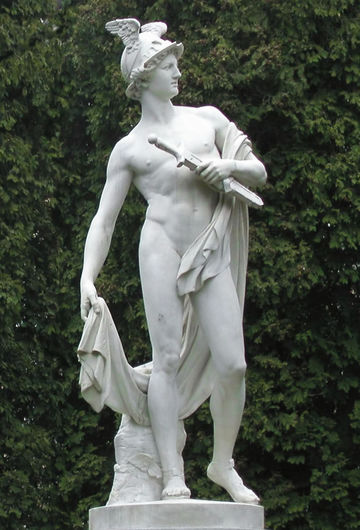Гермес Трисмегист

Гермес слыл в древние времена великим мудрецом, автором священных писаний, алхимических и астрологических трудов. За его ученость и выдающееся мастерство в искусстве и науках египтяне дали ему имя Трисмегист, что означает «трижды великий». Титул «трижды великий» применим и к его роли философа, священнослужителя и царя.
Вознесенный Владыка Гермес Трисмегист также известен как Бог Меркурий. Гермес провел на Земле десятки тысяч лет. Он жил на Атлантиде, ходил по ее улицам, посещал ее храмы и залы обучения, распространял там свое учение. Он считается великим архетипом посланника богов.
Джеймс Кэмпбел Браун пишет в своем труде «История химии»:
Ряд ранних египетских книг приписывают Гермесу Трисмегисту, кто был, возможно, реально существующим ученым, либо олицетворением целой плеяды писателей… Некоторые отождествляют его с греческим богом Гермесом [тождественным римскому богу Меркурию] и египетским Тотом… Египтяне считали его богом мудрости, письма и летоисчисления.[1]
The historical record
Until the seventeenth century, Hermes was thought to have been a contemporary of Moses. His writings were considered by Christians to be almost as sacred as the Bible. Church Father Justin Martyr even went so far as to compare him to Jesus. The Greek Church Father Clement of Alexandria spoke of forty-two “Books of Thoth” dealing with priestly education, temple ritual, geography, astrology, guidance for kings, hymns to the gods and medicine. Regrettably, these were lost in the burning of the library at Alexandria.
Scholars today tell us Hermes was an ancient Egyptian sage, or perhaps a succession of sages. They believe that a whole line of teachers or a priesthood may have written under the name Hermes. The prevailing theory is that the Hermetic writings may span several centuries, dating as late as the first or second century A.D.
According to an ancient Egyptian historian, Hermes wrote 36,525 books. His subjects included alchemy, astrology and theology. He was looked to as the custodian of wisdom and literature. In order to enlighten the people, Hermes had his instructions engraved in hieroglyphics upon tables or columns of stone throughout Egypt.
Some have placed Hermes in the time period before the Flood. Archaeologist James Churchward traces Thoth back to the days of Atlantis. The Egyptians honored Thoth as the god of wisdom, learning and literature. They saw him as the inventor of all arts and sciences, including writing, arithmetic, algebra, geometry, theology, political economy, medicine, surgery, music and musical instruments. He was believed to be the scribe of the gods.
Scholar Hargrave Jennings writes:
Another Thoth, or Hermes, is said to have lived at a later period. He was equally celebrated with the former, and to him is particularly appropriated, by some, the name of Trismegistus. According to Manetho [an Egyptian priest and historian c. 300 B.C.], he [this second Thoth] translated from engraved tables of stone, which had been buried in the earth, the sacred characters of the first Hermes. He wrote the explanation of them in books, which were deposited in the Egyptian temples.[2]

The emerald tablet
На Гермеса Трисмегиста ссылались как на отца алхимии. Согласно одной легенде, в его гробнице нашли изумрудную пластину с вырезанными на ней указаниями Гермеса по изготовлению золота. Эта изумрудная скрижаль содержала известную алхимическую аксиому Гермеса: «То, что внизу, подобно тому, что вверху. А то, что вверху, подобно тому, что внизу».[3]
Один древний автор, утверждавший, будто видел этот камень, сказал, что это был изумруд, на котором иероглифы не выгравированы, а изображены в виде барельефа. Материал был когда-то в жидком состоянии, подобном расплавленному стеклу, затем его залили в форму и с помощью алхимических средств наделили твердостью подлинного изумруда.
Долгое время в школах мистерий к этой изумрудной скрижали относились как к одному из древнейших и наиболее глубоких свидетельств духовной алхимии. Она дает алхимическую формулу, которая использовалась адептами и алхимиками в течение многих тысяч лет для обретения основ понимания как физической трансмутации, так и духовного возрождения. Однако внутреннее значение ее утверждений скрыто от всех, кроме истинных алхимиков.
Вознесенный Владыка Гермес дал учение об изумрудной скрижали сердца:
Я, Гермес, посланник Богов, а также тот, кого называли Меркурием, оставался [на Земле] десятки тысяч лет и более, чтобы в качестве напоминания на изумрудной скрижали вашего сердца могли быть начертаны буквы Закона.
Вот, узрите: сейчас ваше Святое Я Христа, жрец философ ученый, служащий у алтаря необратимого изменения, снимает покров с изумрудной скрижали в тайной обители вашего сердца. Именно это изменение должно произойти, так должно быть, ибо Я ЕСМЬ, а также ибо и ты есть Богочеловек.
Гермес учил нас
не пренебрегать сердцем и ежедневно призывать священный огонь для растворения и трансмутации всей черствости сердца, духовного невнимания и записей смерти, окружающих солнечный центр вашей сердечной чакры. Давайте будем неуклонно развивать сердце, ведь оно – источник жизни.[4]
The Hermetic tradition
The Hermetic tradition teaches that it is through mystical experience that man attains liberation. Scholar Sidney Spencer writes:
The Hermetic mystic sees his unity with all beings. The purgation and illumination of the soul which he attains brings him the consciousness of universal fellowship, and it is his task to do good to all.[5]
In the Mahatma Letters the Master K.H. praises Hermetic philosophy:
Hermetic Philosophy suits every creed and philosophy and clashes with none. It is the boundless ocean of Truth, the central point whither flows and wherein meet every river, whether its source be in the East, West, North, or South. As the course of the river depends upon the nature of its basin, so the channel for the communication of Knowledge must conform itself to surrounding circumstances. The Egyptian Hierophant, the Chaldean Mage, the Arhat, and the Rishi, were bound in days of yore on the same voyage of discovery and ultimately arrived at the same goal though by different tracks.[6]
According to scholar Walter Scott, some of the Hermetic texts may have been written down by the pupils of Ammonius Saccas, a renowned third-century Alexandrian teacher and one of the founders of the Neoplatonic movement. He was a teacher of Origen. Helena Blavatsky considered that the most important goal of the Theosophical Society was to revive the work of Ammonius Saccas. Blavatsky wrote:
It was Ammonius who first taught that every religion was based on one and the same truth; which is the wisdom found in the Books of Thoth (Hermes Trismegistus), from which books Pythagoras and Plato had learned all their philosophy.[7]
Today, fewer than twenty sermons and some additional fragments of Hermes’ teachings remain. In 1945 three Hermetic tracts were discovered at Nag Hammadi, thus indicating a link between the Gnostic and Hermetic schools. The Gnostics, who flourished in the second century A.D., believed that the most important element in the soul’s spiritual quest was gnosis—a Greek word meaning “knowledge.” We see this same principle reflected in the Hermetic teachings. Scholar Giovanni Filoramo says:
The Hermes texts were written in the form of gentle scholarly dialogues in which Hermes teaches a closed group of disciples. They are imbued with an irrepressible desire for knowledge of God. Their ideological structure is an attitude of genuine, deep devotion as the way to knowledge of oneself and of God.[8]
The lineage of the planet Mercury
Вознесенный Владыка Гермес является покровителем Эль Мории и всех тех, кто пришел с планеты Меркурий. Эль Мория объясняет:
Жизневолны сыновей и дочерей Бога, которые эволюционировали на Меркурии, затем служили с Санатом Кумарой и живут сейчас на Земле, пришли из эволюции, которую мы знали в далеком прошлом на другой планете. Там существовала проблема света и тьмы…
Видя ее и получив наставления от Бога Меркурия, мы осознали, что неколебимая преданность воле Бога, привлечение энергии внутрь – к алмазной точке своего [высшего] Я, использование меча голубого пламени и овладение мастерством в применении фохатических ключей приведет к победе…
Бог дал нам необходимые энергию и силу во время той битвы миров на Меркурии. Он сделал это только потому, что мы были готовы уравновешивать трехлепестковое пламя, искать мудрость и даруемую ею силу, разжигать любовь в каждой клетке и в пламени каждой клетки, насыщая тем самым свои ауры такой любовью, что исчезла бы сама вероятность злоупотребления хотя бы одним эргом Божьей силы через тиранию в любом ее проявлении…
Возлюбленные, победа на Меркурии одержана еще не полностью. Большая часть этой победы одержана, однако некоторые сыны света, а также определенные падшие не достигли высшей точки своей эволюции. Поэтому они были определены в другие планетарные дома и системы. Некоторые из падших присоединились к [духовно] отсталым эволюциям, которые, в конечном итоге, воплотились на Земле. Некоторые из сыновей и дочерей Бога отправились на Венеру и позднее последовали за Санатом Кумарой на Землю.[9]

The arts of communication
Гермес призывает тех, кто возьмет на себя защиту Истины через искусство передачи информации.
Я – Посланник Богов, и у меня есть послание, которое я должен передать вашим сердцам…
I speak of the lineage of the initiates of Mercury—those who have fashioned their skill by the sword and the pen, those who have acquainted themselves with the mind of God and have claimed that mind, who have come from a lineage that antedates myself. Truly, there is a lineage of those who have been called Hermes, the name being the title of an office. Thus, there is a descent of those whose craft has been to set forth in writing and in other forms of communication that which is Real, that which is unreal, that which is necessary information to the body politic round the world that they might know and understand the way to go....
There are those whom I myself have trained under my mantle as God Mercury. We who bear the shield and the armour of the Sun must therefore go up and down the nations of the earth and call out those who have the original communication skills, who practiced those skills in ancient times and on ancient continents and are willing to once again take the lead in the dissemination of the Truth and in exposing error. You must come forward! For the Truth must be made known....
Set forth the message! Set forth the platform for its delivery in your area of expertise! And if you think you have no expertise, go out and get it, and study and prove yourself to be one who will make that statement and make that name, not only for yourself but for God and all the ascending ones. I AM Hermes and I say to you: I shall overshadow any of you, each and every one of you, who will learn these disciplines.[10]
His service today
At the present time, Hermes serves in the retreat in Arabia where he is the patron of the science of alchemy—which Saint Germain has defined as the all-chemistry of God. His aura is a brilliant gold; he wears white robes and has long hair. He is the image of the ancient wisdom and the androgynous nature of the Deity.
See also
For more information
MP3 audio album Emerald Matrix: The Perfect Light includes a lecture on Hermes and a dictation by him.
Sources
Mark L. Prophet and Elizabeth Clare Prophet, The Masters and Their Retreats, s.v. “Hermes Trismegistus (God Mercury).”
- ↑ James Campbell Brown, A History of Chemistry from the Earliest Times till the Present Day (London: J. & A. Churchill, 1913).
- ↑ Hargrave Jennings, The Divine Pymander of Hermes Mercurius Trismegistus (San Diego, Calif.: Wizards Bookshelf, 1985), pp. iii, iv, v.
- ↑ Там же, с. х.
- ↑ Hermes Mercurius Trismegistus, “The Emerald Tablet of the Heart,” Жемчужины мудрости, том 24, номер 73, август 1981 г.
- ↑ Sidney Spencer, Mysticism in Religion (London: Allen & Unwin, 1966), p. 147.
- ↑ The Mahatma Letters to A. P. Sinnett, compiled by A. T. Barker (Theosophical University Press, 1926), letter 85.
- ↑ H. P. Blavatsky, Isis Unveiled (Wheaton, Ill.: Theosophical Publishing House, 1972), vol. 1, p. 444.
- ↑ Giovanni Filoramo, History of Gnosticism.
- ↑ Эль Мория, “The Gemini Mind: For the Governing of Society and the Self,” Жемчужины мудрости, том 24, номер 43, 25 октября 1981 г.
- ↑ Hermes Trismegistus, “The Guild of God Mercury: The Sword and the Pen,” Pearls of Wisdom, vol. 36, no. 42, September 22, 1993.
